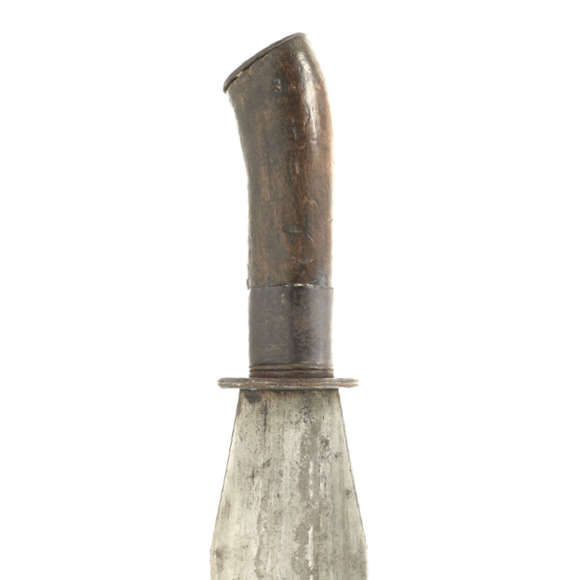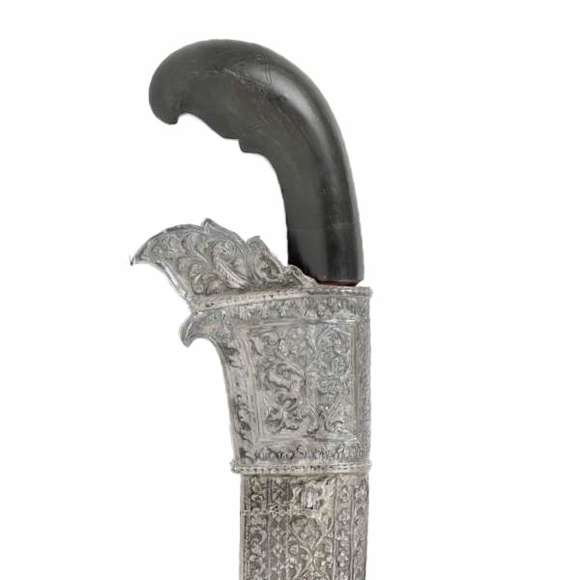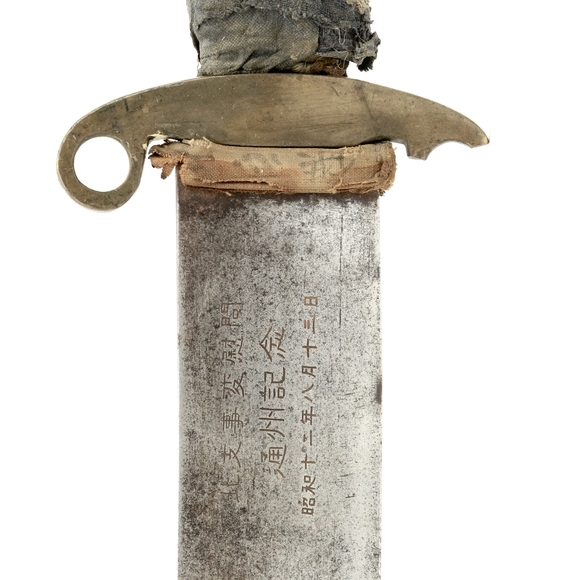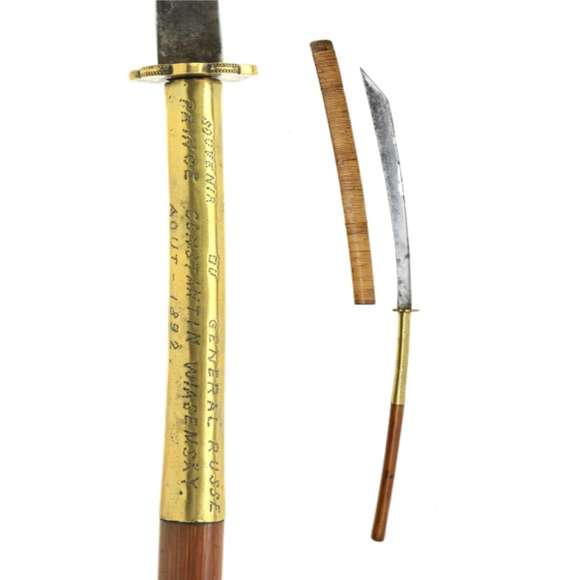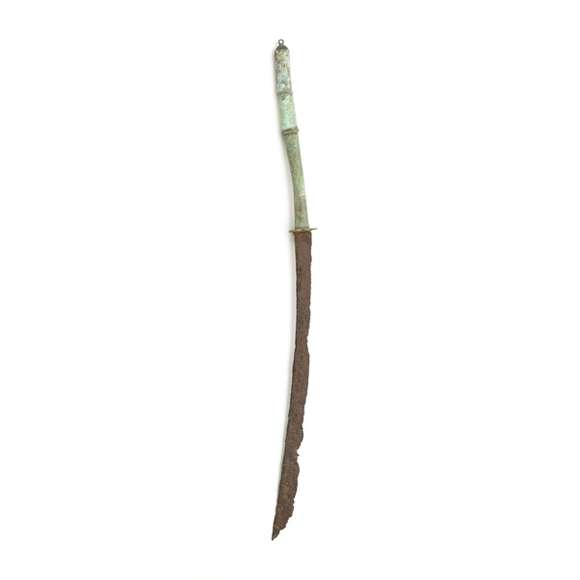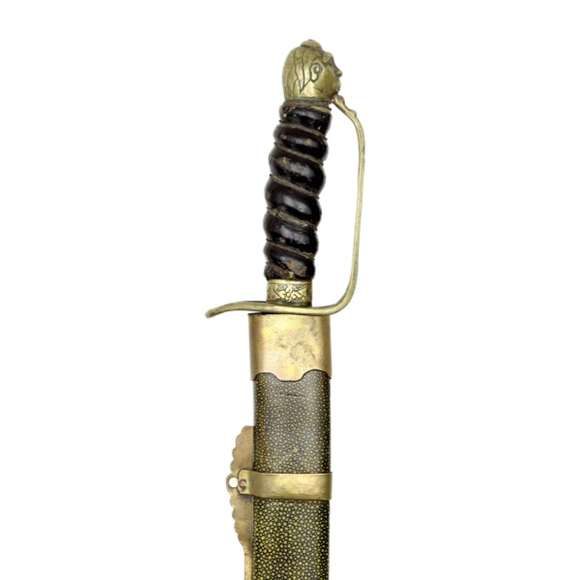Description A rather unusual Vi

Sheathed 72 cm
Hilted sword
Bare blade 44 cm
cm
Hilted sword
Blade only
Hilted
(Notice it misses a guard)
Wood, iron, steel, cherry bark, paper, silk.
Ainu culture, Hokkaido
Ainu sword: 18th-19th century
Box, polish & shirasaya: late 19th to 20th century
Recently imported from Japan
This sword was sold in 2021.
Introduction
The Ainu people were the earliest settlers of Hokkaido, the northernmost island of the Japanese archipelago, and are considered the indigenous people of this area.
Their swords are called emushi or emush. One of the earliest references to Ainu swords is from 1645, when Maarten Gerritszoon Vries observed that they hung the sword of a respectable deceased over his grave.1
Based on the writings of ethnographers and travelers of the 19th century, it is widely believed that the Ainu produced no metalwork and certainly no iron or steel. However, archaeologists have uncovered iron and steel production facilities dating from the late 17th century that prove otherwise.2
Production and possession of iron became strictly regulated by the Matsumae clan of Hokkaido following a 1669-1672 revolt of the Ainu against the Matsumae.3 From then on, many were kept hidden in collections, or as we see in the antique record, some were mounted with short-ish blades unsuitable for actual fighting.4
By the late 18th century, it seems the Ainu were still able to improve on low-quality articles they obtained by trade:
"...although it was strictly forbidden by the Matsumae to give iron material to the Ezo [Ainu], many iron products, including carpenters tools, had been passing to the Ezo [Ainu] for a long time. Such products were always of low quality but when the Ezo [Ainu] received them they transformed them into ones of higher quality." 5
-Furukawa Koshöken, 1788
19th century ethnographers noted that they were primarily used during ceremonies for expelling evil.6 The older the sword, the more powerful it was, and so many wealthier Ainu families kept collections of older swords.
Notes
1. Reize van Maarten Gerritszoon Vries in 1643 naar het noorden en oosten van Japan, volgens het journaal gehouden door C. J. Coen, op het schip Castricum. Amsterdam, F. Muller, 1858. Page 377.
2. Yuriko Fukasawa; Ainu archaeology as ethnohistory; Iron technology among the Saru Ainu of Hokkaido in the 17th century. Pages 48-49.
3. Ibid.
4. See our Ainu sword listed here, and one with a similar non-fuctional blade in the Penn Museum, accession number A469B.
5. Translation by Yuriko Fukasawa. Ibid.
6. John Batchelor; An Ainu-English-Japanese dictionary (including a grammar of the Ainu language). Tokyo Methodist Publishing House, 1905. For the ritual, see, same author: The Ainu of Japan: the religion, superstitions, and general history of the hairy aborigines of Japan. London, Religious Tract Society, 1892.
This example
An Ainu shortsword. It comes in a Japanese box with a label.

It reads:
蝦夷国舞草刀
第弐拾七号
“Ainu country maigusa sword
No 2 pickup no 7″
Maigusa sword refers to a small group of very early forms of tachi with the words maigusa inscribed in the tang. Whoever made the label probably likened the piece to an archaic form of Japanese sword, like the maigusa.
The rest of the label refers to at least two acts of collecting, perhaps during the annexation of Hokkaido during the Meiji period.
Whoever this sword ended up with, he thought highly enough of it to treat it like a Japanese heirloom sword: The box contains an Ainu sword blade in Japanese shirasaya (a resting scabbard) and an Ainu hilt and scabbard held together by a wooden sword called tsunagi. This is how any Japanese collector would keep his prized sword and mounts, separate, to ensure the best survival of the blade.
Blade
The blade itself has also been subject to a Japanese polish, which allows us to see the details in the steel. Interestingly, the sword bears more resemblance to Chinese swords than Japanese, in the fact that it was constructed with a high-carbon edge plate between layers of milder steel. On Japanese swords, the construction tends to have a high carbon steel outer jacket around a softer iron core.
Both sides of the blade have a deep straight groove and a shallower, wavy groove, somewhat coarsely done and typical Ainu in style. Looking along the edge profile there is a very minor recess in the top section of the blade; an indication of more intensive grinding in this area which means either repeated sharpening or damage that was polished out. Such a recess is common on swords that have actually seen action, suggesting a life as a true weapon before it got a purely ceremonial function.
Hilt & scabbard
The hilt is made of a piece of wood with a slit on the reverse side, it is strengthened by bands of cherry bark. Normally, the hilt would have some metal fittings and it would have a guard, which are absent on this example.
The scabbard is made of two halves of wood bound together with rattan. It has a number of domed-shaped iron ornaments and three circular ornaments with three comma-shaped elements called mitsudomoe in Japanese. Some losses due to rusting.
At the end is a flaring endpiece, somewhat reminiscent of Chinese 18th-century styles.
Notes
1. John Batchelor; An Ainu-English-Japanese dictionary (including a grammar of the Ainu language). Tokyo Methodist Publishing House, 1905. For the ritual, see, same author: The Ainu of Japan: the religion, superstitions, and general history of the hairy aborigines of Japan. London, Religious Tract Society, 1892.
2. Reize van Maarten Gerritszoon Vries in 1643 naar het noorden en oosten van Japan, volgens het journaal gehouden door C. J. Coen, op het schip Castricum. Amsterdam, F. Muller, 1858. Page 377


















With markings attributing it to the Tongzhou incident and a Japanese surrender tag.
Collected by a Russian prince from the hill peoples of central Vietnam in 1892.

